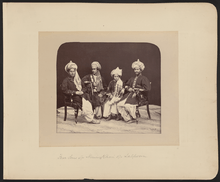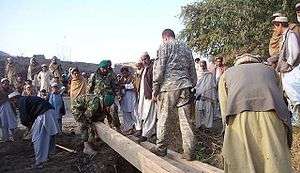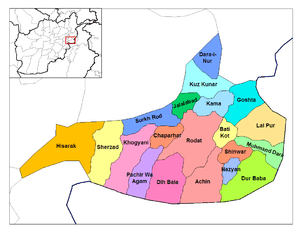Lal Pur District
Lal Pur is a district in the east of Nangarhar Province, Afghanistan, bordering Pakistan. Its population, which is 100% Pashtun, was estimated at 34,516 in 2002, of whom 13,800 were children under 12. The district centre is the village of Lal Pur.



Lal Pur is home to many Afghan statesmen of the past century. The Marchakhel family is the famous family of lalpura. Marchakhel is the sub-tribe of Tarak zai Mohmands. "Khan kor" ( Royal Family of khan) which is a sub-tribe of Marchakhel Mohmands, members of the Royal family are the noblest and powerful among the Mohmands. The khan was regarded as king of Mohmands by many famous Afghans such as Amir sher Ali khan of Afghanistan. Khan was having khani over all the Mohmands and still at the present have influence over lalpura.Mostly Murchakhel are living in Pakistan and they are now basically from Pakistan. Lalpura was a famous trade route for trade from Subcontinent to Afghanistan to Russia (present-day central Asian republics) and other countries, the khan would collect tax from the traders, no trade would pass without the khan's permission. Lalpura was considered as a kingdom, Khan had his own army his own rules. The khans had fought many times with the Britishers during the Afghan wars. Saadat khan of lalpura was the father in law of Amir of Afghanistan and was the grandfather of the famous Amir Ayub khan of Afghanistan also known as The victor of Maiwand or The Afghan Prince Charlie.
The Marchakhel were the chief of Mohmands and had influence over all Mohmand tribes except the Safi Mohmand which were under the influence of khan of Bajawar. Marchakhels ruled over all Mohmands. Marchakhels rule was from lalpura, Afghanistan to Peshawar, Pakistan. Sardar khan Murchakhel son of Asghar khan, Amaan ullah khan(Jogani) Abdul wahid khan and Samaat khan sons of Dilawar khan Murchakhel, Iftikhar ali Murchakhel. Muchakhel is still huge family and mostly present in pakistan different cities.
External links
| Wikimedia Commons has media related to Lal Por District. |
- Map of Lal Pur district (PDF)